

Meters Coming to 18th Street Commercial Strip
BY CONNOR FITZPATRICKThe San Francisco Municipal Transportation Agency (SFMTA) will install parking meters along both sides of 18th Street between Connecticut and Texas streets by the end of the year. The meters will operate from 9 a.m. to 10 p.m. with four-hour time limits, charging $1.50 for sixty minutes.
Residents and businesses located along the 18th Street business corridor can purchase parking permits. Vehicles with residential permits will be exempt from posted time limits. Residents are allowed up to four permits for vehicles registered to a specific eligible address. Businesses can purchase one personal vehicle sticker, as well as up to three additional permits for vehicles registered to the enterprise with commercial
license plates. The annual fee for permits is $144 for passenger vehicles; $108 for motorcycles.
In September SFMTA’s Sustainable Space Division held a public hearing to discuss the plan at San Francisco City Hall. At the meeting, operations manager Tom Folks stated that the division believes it has “general neighborhood support” to install meters. When asked by the View how the neighborhood consensus was determined, transit planner Mari Hunter replied, “it started with a request from the merchants along 18th Street on these two blocks. We went out to the neighborhood and communicated, knocked on doors, and spoke with everyone if they were there ... created a proposal, sent it back out, and have continued to receive support.”
 PHOTO: Bettina Cohen
PHOTO: Bettina Cohen
Mission Bay Businesses Begin to Blossom
BY BETTINA COHENFor a timeless moment, the retail economy along Fourth Street from Channel Street to Mission Bay Boulevard North limped along. Early arrivals to Mission Bay kept waiting for a “critical mass” of residential and commercial complexes to be built to trigger a deluge of neighborhood-serving merchants.
If the grand openings taking place along the corridor during the spring and fall are any indication, critical mass has arrived. San Francisco Custom Chiropractic, at 1365 Fourth Street, launched in October. Row House, a boutique fitness studio which shares the same vestibule at 1375 Fourth Street, opens this month, offering clients four days of
free classes. So too does Mission Bay Wine and Cheese, just off the corridor at 114 Channel Street. La Belle Cuisine Bakery anticipates moving into the Fourth Street side of the One Mission Bay complex by year’s end.
These shops will supplement the offerings sold at Gus’s Community Market, a neighborhood mainstay since it opened at its prominent 1101 Fourth Street location last year. Produce bins flank the store’s entrance, customers eat at sidewalk tables, and the colorful corner conveys an energetic vibe to pedestrians crossing the Fourth Street Bridge and perambulating south of Mission Creek.
MISSION BAY continues on page 10
However, neighborhood consensus doesn’t appear to be as solid as SFMTA indicated. When asked to comment, multiple business owners and workers along the 18th Street business corridor expressed varying degrees of support for meters.
“I’m against it!” said Mary Petrin, owner of Collage Gallery.
This sentiment was echoed by staff at Bell and Trunk Flowers and Provender Coffee, who said that many people who labor along 18th Street drive to work. Currently, the business corridor features parking with no time restrictions, save for Monday morning street cleanings, a rarity in San Francisco. The surrounding streets have Residential Permit Parking with two-hour limits. Finding long-term free parking in the area is becoming
impossible.
“I’m all for it,” stated Aran Healy, owner of Ruby Wine. Healy said that because of the lack of a time restrictions along the business corridor many people park their cars for hours or even days. Healy favors meters and has voiced his support for them to SFMTA, believing that they’ll enable more customers to park. “Turnover is good for business.”
“It is what it is,” said Dominic, who works at Christopher’s Books. While Dominic doesn’t support meters, he believes they’re inevitable in San Francisco’s constantly changing landscape.
Tee Minot, owner of Christopher’s Books, has mixed feelings about meters, but said that the proposal is a good one if it provides comfort to her customers.
Swarm of Fossil Fueled Backup Generators Continues to Grow, With No Response from Regulators
BY DANIEL IDZIAKIn May, The Potrero View reported that according to Bay Area Air Quality Management District (BAAQMD) data there are roughly 6,500 fossil fueled backup generators, “BUGs”, in the San Francisco Bay Area, with some 800 in San Francisco alone. These numbers exclude the thousands of smaller gasoline, propane, and diesel-powered generators located in backyards and garages. All emit polluting air emissions, much of which may go undetected by air quality regulators.
BUGs serve a vital function, proving emergency power to hospitals, water suppliers, and Internet server farms, among others, when the grid goes down or Pacific Gas and Electric Company (PG&E) shuts it off in response to elevated wildfire risks. They’re also a pernicious pollution source; testing the predominately
diesel generators alone results in emissions equivalent to having more than 7,000 additional cars on area roadways. They represent a kind of shadow grid, providing power to those who can afford them, often with taxpayer monies, while others sit in the dark, coughing on the fumes of their well-to-do and forward-thinking neighbors.
According to the San Francisco Chronicle , Generac experienced a 600 percent increase in sales of its generators in the Bay Area between June 2018 and June 2019. In July, NBC Bay Area news reported that the East Bay Municipal Utility District (EBMUD) rented 29 portable emergency generators to install at “critical [water] pumping stations” from August through November in anticipation of fire season power cuts, at a taxpayer cost of more than $400,000. Accord-
BUGs continues on page 12
Nashville
BY STEVEN J. MOSSOver the years I’ve learned that how I experience a place or activity is greatly influenced by what I bring to it. This was certainly the case on a recent trip my wife, Debbie, and I took to Nashville after dropping off our only child, Sara, at the University of Puget Sound to start her freshman college year. We were deeply mourning the end of an excellent 18-year run, celebrating our collective successes, and anxious about the future.
Our chick had flown the nest, prompting us to temporarily flee south in search of distractions. Too restless to stay in one place, we vowed to keep moving, remaining no more than a day or two at a given hotel.
Nashville is one of those cities people from Los Angeles, New York, and San Francisco talk about moving to, alongside Asheville, Austin, Charleston, and Portland. It’s main, really only, claim to tourism fame is its music scene, which is cheap, abundant, and dominated by what’s known as “country” but which more aptly might be called “Mostly White people singing about a deep yearning for meaning in the context of occasional bar fights and a long list of cover songs.”
We began our stay at Field House Jones, a brand new allegedly hip hotel located near a neighborhood a friend recommended as “the most walkable area in a city that’s not made for walking.” It was indeed stylish, in that it had complimentary gourmet donuts on offer 24/7, a candy bar, and groovy music-themed lobby décor. But none of the main amenities, such as a rooftop bar, were yet open, giving the place a bit of a half-constructed in Baja California feel; I lost-my-last-dollar in a midnight poker game and now I can’t finish constructing my hotel. The nearby “best pedestrian experience” consisted of a gigantic liquor store, sad looking vape shop, and two-block handful of semi-festive bars and restaurants. The Field House highlight, as Debbie kept exclaiming, was that we were probably the first people to sleep in our room’s bed, a rare triumph for any traveler.
We made our way to the Grand ol’ Opry, which to our mild surprise is located in the midst of what looks like a big box shopping mall, except the giant boxes are various entertainment and lodging venues, including the Opry
itself. The singers were largely Top 40 country meh, both in terms of their performances and lyrics; one recommended spending life “killing time” drinking beer and driving around aimlessly until it was time to go to heaven. Words to live by. The highlights were the blue grass masters, Michael Cleveland and the Flamethrowers, and comedian Gary Mule, who’s snappily delivered corny jokes, many of which were set in a retirement home, were laugh out loud funny. It helped that the average age of the audience was maybe 10 years shy of becoming eligible for the gags.
About halfway through the show I whispered to my wife, “All the men here look gay.” “You’re right!” she exclaimed. Once seen we couldn’t un-see: the short cropped or well-coiffed hair, tucked-in plaid shirts, fitted t-shirts worn by guys in their 50s and up were sharply reminiscent of what you might see in the Castro of the same demographic. Which group copied which, we wondered. Was the country music scene rife with down-lows, escorting their cowboy-booted “beards” on bent elbows to the nearest Kiwanis Club?
We moved to the Bobby Hotel, located several blocks from Nashville’s honkytonk strip. The place was more confidently hip than Field House, with a lobby in which actual musicians might hang. Our room was huge, but dark, with a single sliding glass window leading to a small balcony tucked in a corner. The kind of place in which you either heavily drink, commit suicide – for extra fun first imagining the various ways self-murder could be done, and the potentially flamboyant consequences to the room – or just don’t stay too long during the day. Debbie loved the rooftop pool, which held a careful balance of chaise chairs, lazy cabanas, a renovated 1950s-era Winnebago turned lounge, and intermittently lively crowd, including on one afternoon a swarm of photographersin-training clicking at a single voguing female model.
We strolled several blocks to the Listening Room, which offers a nightly rotating set of three to five musicians who chat briefly about their lives and careers between performances. All the PUBLISHER’S VIEW continues on page 13


Editor,
Thank you for your excellent newspaper! I pick it up every month at The Good Life Grocery on 20th Street or at the Potrero Hill Library when I come, as I often do, to be with my family, including grandchildren, who live on the Hill!
Please keep publishing the View!
Susan LucasInner Sunset
Editor,
Given that the September article by J. Eric Miller, “Better Bus Service, Fewer Parking Spots Coming to Potrero Hill,” focuses much more heavily on the latter — the repurposing of a handful of hundreds of on-street parking spots — I’d like to express my enthusiasm for the potential benefits that this change provides transit riders. The rerouted 55-Dogpatch will provide a direct connection for more riders on Potrero Hill, in Dogpatch, and from the Mission to the commercial district on 20th Street and to the 22nd Street Caltrain station, in addition to the existing connections to 18th Street, Third Street and the T-line. Further, I’d suggest that the push to move pull-in stops to flag stops would make riding Muni more difficult for anyone carrying cargo – such as groceries – families with strollers, and those who rely on mobility devices, such as a walker or wheelchair; navigating through parked cars to board the bus is an unnecessary hassle and slows down bus service and any car traffic that gets stuck waiting for it.
Miller quotes representatives from several businesses lamenting the parking situation, including The Good Life Grocery. The article doesn’t indicate whether the businesses have surveyed their customers, but evidence from elsewhere indicates that small businesses typically thrive on corridors when transit service improves. Regardless, parking needs would be better met by advocating for a loading zone and/ or a handful of metered spots to ensure that the business can receive deliveries and that there’ll be spots available for customers who need them, rather than fighting bus improvements.
“Efforts Continue to Improve Mission Bay Mobility in the Face of New Demands” by Bettina Cohen in the View’s August issue gives a more balanced look, pointing out how many people the various transit improvements will help move. This article also notes that while the 55-Dogpatch will repurpose 20 existing parking spots the rerouting of the 22 will restore some number; there may not even be a net loss.
The San Francisco Municipal Transportation Agency estimates that public transit is responsible for about a quarter of all trips made in the City, a similar proportion to solo driving. Our curb space tells a much different story, with the vast majority dedicated to storing cars. It’d be great if a View reporter could seek out transit riders who stand to benefit from these improvements for your next story; it’s not hard to find people waiting for the next Muni bus to show up.


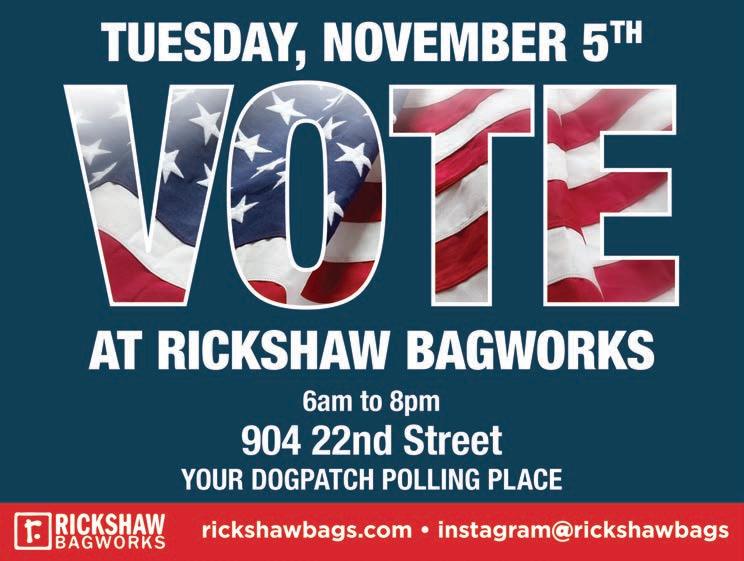
Policing of Public Drug Use Challenging
BY J. ERIC MILLERAssembly Bill 362 – which’d allow San Francisco to operate a trial facility in which drug users can inject themselves – was reintroduced in the State Legislature last February by State Senator Scott Wiener and Assemblymember Susan Eggman after being vetoed by Governor Jerry Brown in 2018. The measure is a response, in part, to costly and inefficient enforcement of existing drug laws, which result in public use of illegal narcotics in the City going largely unchecked.
Keith Goldstein, Potrero Dogpatch Merchants Association president, acknowledged the prevalence of public drug use in San Francisco, but wasn’t sure how best to address the problem. “I am not aware of arrests,” said Goldstein. “Bayview Captain Troy Dangerfield told us they do not make arrests for open drug use. I doubt that arresting open-air drug users is a good solution, but I suspect that our current policy will lead to more drug users coming to the City and taking advantage of the fact they can shoot up openly with impunity.”
Sargent Brian Kneuker of Bayview Station confirmed the existence of public drug use and associated complaints about it. “We get those calls,” he said.
Other San Francisco Bay Area municipalities are confronting visible drug use and the challenges of addressing it. “Anecdotally, I can confidently say that we have seen a significant uptick in intravenous drug use in our city over the last few years,” said Lieu-
tenant Ryan Johansen of the San Bruno Police Department. “This does present a number of challenges for us as a law enforcement agency. Dealing with intravenous drug users is extremely dangerous for first responders, as used needles can transmit dangerous disease very easily. Searching or treating a person and/or their property while being sure not to stick yourself on an uncapped needle is very difficult, scary and dangerous.”
Those who come across a used syringe in parks, backyards, or streets should text a picture with its location to San Francisco’s Needle Pick-Up Crew, 415.810.1337, according to Brittany Valley, Syringe Disposal Associate. Valley is part of a ten-person cleanup crew operated by the San Francisco AIDS Foundation and funded by the San Francisco Department of Public Health.
Lieutenant Elle Washburn of the San Jose Police Department acknowledged that public drug use exists in her jurisdiction as well, though not on the scale seen in San Francisco. “There is not a visible prevalence of people using hypodermic needles and controlled substance out in public as one might find in San Francisco. If an officer were to on-view that behavior in public, the person would be arrested and cited for the simple possession of a controlled substance and/or hypodermic needle. The drugs would be seized and booked as evidence. The only time we would attempt to book into jail is if they were in possession of a quantity consistent with sales of the controlled substance,

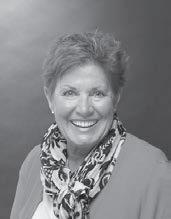
which is a felony.”
Under California Health and Safety Code 11364 HS it’s a misdemeanor punishable by up to six months in jail or a $1,000 fine to possess drug paraphernalia; anything used to inject or smoke a controlled substance. While the law extends to crack pipes and coke spoons, it doesn’t cover syringes if they’ve been legally purchased or otherwise obtained, such as from a needle exchange program.
Under California Health and Safety Code 11350(a) HS possession of a controlled substance without a valid prescription can result in up to a year’s jail time, or a $70 fine for first offenses.
Defendants charged with violating California Health and Safety Code 11550 HS – a misdemeanor offence to be under the influence of a controlled substance – can also be sentenced to a year in jail and must serve a minimum of ninety days in county jail even if granted probation after being convicted. California Penal Code 1000 allows for defendants to undergo pretrial diversion; charges are dropped if the perpetrator successfully completes a drug rehabilitation program. Additionally, California Proposition 36, The Substance Abuse Treatment Act of 2000, makes it possible for offenders to serve their time in a drug treatment program instead of jail.
“Should someone be arrested for a felony,” posited Washburne, “With the intention of booking them into jail, and they require medical clearance before booking, we would then transport them to the hospital for treatment and medi-
cal clearance prior to taking them to jail. This can be time consuming, but it is reserved for felony cases. Should we arrive at the hospital and find out they need to be admitted for any reason, we would likely get Watch Commander approval to 849b them pending District Attorney review; meaning, they get released that night, but the charges still go to the DA for review/filing. It would not be worth tying up an officer all night, even if it was for a felony drug possession. We would reserve a hospital booking for violent felons.”
“Context really is key,” explained Johansen. “It’s easy to try and oversimplify the problem. It’s a wide-spread issue that, at present, has correlations in mental health issues and homelessness challenges. Law enforcement should have a seat at the table of that larger conversation, and, at the same time, we have a role to play. See, not at all simple. All things considered, we focus on fair and impartial policing as well as equal protection under the law. We try to keep subjectivity out of our enforcement efforts. We follow our department’s policies. Should the Department change how we effectively enforce narcotic offenses, then our officers would adapt accordingly.”
Receive the paper at your home or office Subscribe to the View !
Annual subscription: $60 www.potreroview.net/subscribe/ production@potreroview.net



Study Examines Possible Improvements to Mission Bay, Showplace Square, and South-of-Market
BY BETTINA COHENThe San Francisco Planning Department is studying how best to redesign roads, public transit and open space in ways that smooth connections between Showplace Square, Western and Central South-of-Market, and Mission Bay. The Showplace/ SoMa Neighborhood Analysis and Coordination Study (SNACS) will also identify possible sites for additional market-rate and affordable housing, and evaluate demand for new Production, Distribution and Repair (PDR) spaces.
“The purpose of this effort is to have a look at how we can better, more seamlessly, merge the edges of all of these plans, with all the development there, and set a more unified policy and design framework for future proposals that might pop up in this vicinity. We’re looking for opportunities for parks, open spaces, and street connections for pedestrian and bicycle use, as well as vehicles, with the lens that Caltrain will be underground someday, about a decade from now,” said Joshua Switzky, Planning Department program manager.
The Caltrain Electrification project is a key component of the Caltrain Modernization Program to electrify the corridor from the San Francisco Caltrain Station at Fourth and King streets to approximately the Tamien Station in San Jose, replacing dieselhauled with electric trains. The project is expected to be completed by 2022. Tracks are already being electrified south of the Fourth and King Street railyard. Once tracks into San Francisco are fully electrified Caltrain will be undergrounded north of Pennsylvania
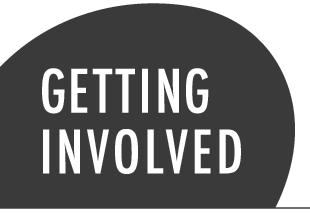
Green Benefit District
and 22nd Street, Switzky said.
Market rate housing and office space are more lucrative to build than PDR. Planners want to identify ways the City can ensure that new, affordable, PDR is created to meet future production needs “We’re strong supporters of maintaining PDR zoning, but that doesn’t necessarily mean new PDR will get built,” Switzky said. “It costs more to build a PDR space than you get back in rent.”
To address market imbalances between residential, commercial, and PDR space, mixed-use planning codes are being developed for new construction, with PDR on the ground floor, offices or residential units on upper levels. This type of “cross-subsidy project” was permitted at 100 and 150 Hooper Street, where the Manufacturing Foundry opened at the beginning of this year. It was the first manufacturing building constructed in the City in decades, and brought affordable, light industrial space to the ground floor of the new Adobe offices. Sister nonprofits SFMade and PlaceMade are headquartered here.
“Most people think of PDR as oldschool, getting dirty stuff, but it’s a lot of other things,” Switzky said. “…more advanced manufacturing and prototyping, robotics and other high-end things of that nature. Not just the Blue Collar but the knowledge-based sector. Self-driving car research, the mechanical side, what’s under the hood.”
Fast, last-mile distribution for online orders, such as Amazon same day delivery, are another present PDR need. Traditional PDR that continues to need space include food and drink production – bakeries and breweries – wholesale produce and flower

The GBD will hold community meetings on possible pedestrian improvements to 20th St between Indiana and Tennessee in the coming weeks. If you are interested in this or other GBD projects, please check our website – GreenBenefit.org – or contact us at info@GreenBenefit.org.
You are always welcome to join the GBD board for our monthly meetings on the 3rd Wednesday of each month (except December) at 6:30 PM at 654 Minnesota St, 3rd Fl. Check the GBD website for agendas and more information..
First Saturdays in Dogpatch: A neighborhood-wide event held monthly, rain or shine
• Explore neighborhood shops 11 a.m. to 7 p.m.
• Enjoy great food and drink 11 a.m. to 11 p.m.
• Discover maker market at Center Hardware and 1234 Indiana Street, 11 a.m. to 4 p.m.
• Be inspired at gallery openings at Minnesota Street Project, 6 to 8 p.m.
• See all the details at LoveDogpatch.com
Bay Area makers, small businesses and food trucks: Pop-up in Dogpatch the first Saturday of every month. Find out more at https://bit.ly/2Lo5ekM
Potrero Boosters Neighborhood Association
Be in the know. Meet your neighbors. Make the Potrero a better place. Monthly meeting: last Tuesday of the month, 7 p.m. at the Potrero Hill Neighborhood House. 953 De Haro @ Southern Heights.
markets, auto repair, and services that support lodging and other Citybased businesses.
“If we don’t maintain the PDR sector, the City’s going to suffer. It’s better for the long-term resiliency of the City’s economy,” Switzky said. “If you can’t get something made or printed in the City, it just becomes more expensive to live and do business in the City, as opposed to going out to the East Bay. PDR is a really essential part of the City’s economy, and also its diversity. It creates jobs for people without college degrees, who want to work with their hands, have meaningful work, as opposed to retail jobs, or White-Collar office jobs.”
Some SNACS components are being reviewed separately, with independent environmental impact studies. These include Recology’s 900 Seventh Street project, which requires zoning changes to accommodate five proposed towers that’d host residential, office, and PDR uses on 6.25-acres; and a proposed life science facility at 1450 Owens Street, Mission Bay’s last remaining commercial space. The Owens Street developer, Alexandria Real Estate Equities, wants to build a 183-foot tower on the site, triggered the need to change the Mission Bay South Redevelopment Plan, which restricts any building at that location to the height of the adjacent Interstate-280 freeway ramp, or approximately 39 feet. De -
mand for biotechnology research space is quite strong; all existing laboratory and office areas are leased.
A series of community meetings will be held to discuss SNACS elements. Jeremy Shaw, Planning Department senior planner, presented a study overview to the Mission Bay Citizens’ Advisory Committee in September. A land use workshop will take place on November 19, 6 to 8 p.m., at the new Seven Stills brewery, 100 Hooper Street. In February a workshop focusing on the combined network of public open spaces, streets, and transportation issues, will be held, with another gathering concentrating on public benefits, land use and design expected in April.
An environmental assessment will likely be initiated next year. “The level of environmental review, if any, will be contingent on the Study findings. If required, environmental review is not expected to begin before summer 2020,” Shaw said. SNACS is expected to conclude in 2022.
In addition to public workshops, Planning Department staff will attend citizen advisory committee and neighborhood meetings. “We’re always seeking public comment and input,” Switzky said. “We try to collect input in a variety of ways. Email, online surveys, meetings with groups of people independently of public workshops. We make as many avenues available as possible.” For a

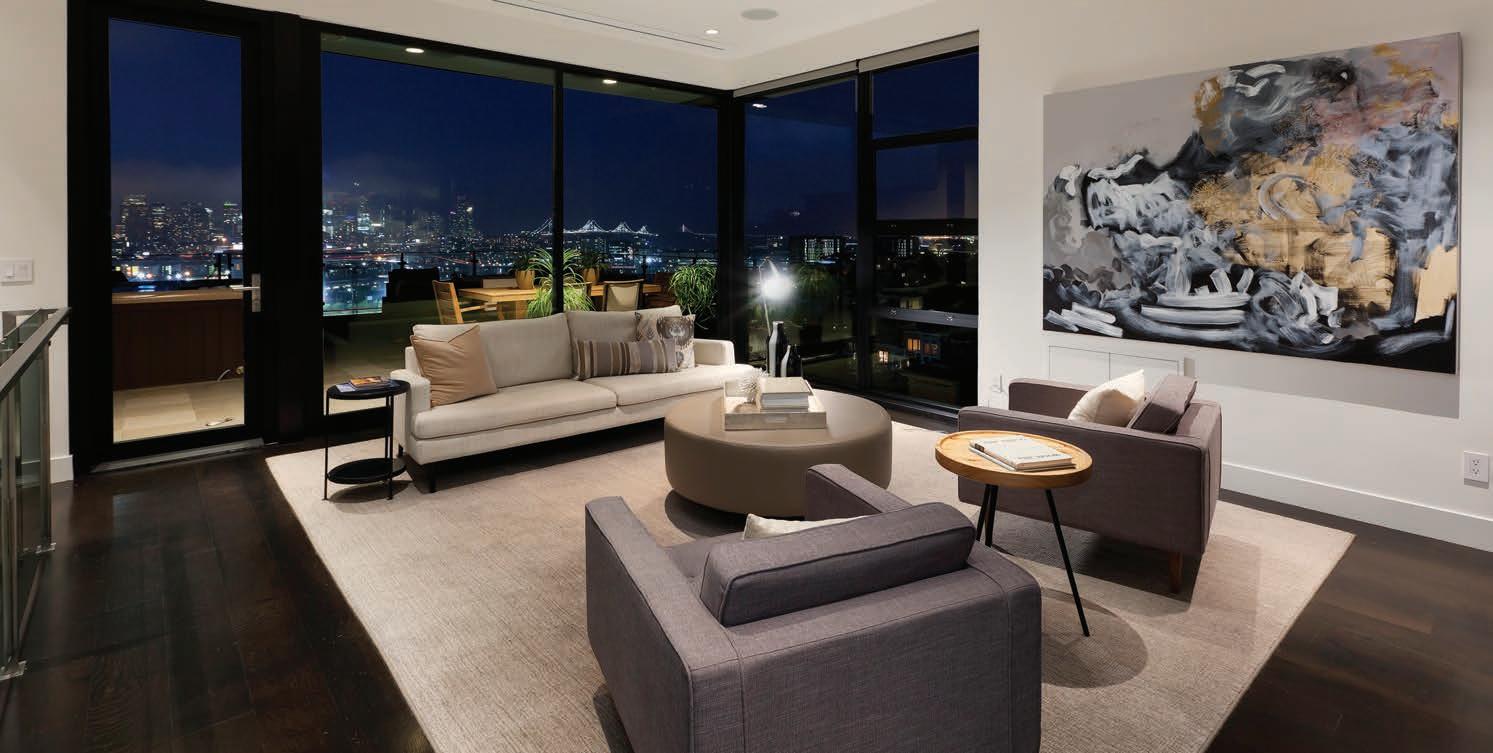
Low interest rates and powerful demand have continued to keep the Potrero Hill market strong. Many homes have attracted multiple offers after short periods on the market.
If you have been thinking of selling your home, now may be an excellent time to take advantage of strong demand from buyers.
Sales Prices for All Potrero Hill Homes Sold in 2019*
The average sales price for a home on Potrero Hill this year has been $2,265,152.
If you’d like a free report on the value of your home, call Tim Johnson at 415-710-9000.

Tim Johnson
415.710.9000
tim@timjohnsonSF.com
www.timjohnsonSF.com
DRE 01476421
Potrero Hill Recreation Center Basketball and Tennis Courts Up Their Games
BY JESSICA ZIMMERIn August, San Francisco Recreation and Parks completed extensive renovations to the Potrero Hill Recreation Center’s basketball and tennis courts, resurfacing roughly 7,100 square feet of space. New basketball backboards and hoops were mounted, with fresh fencing around the tennis courts.
“We installed new tennis nets and new black-painted posts in the tennis courts as well as a double gate to allow for easier access to the tennis courts. We trimmed the trees around the tennis courts. We also replaced the fabric inside the fence to the tennis courts with black, state-of-the-art synth fabric. We raised the benches near the tennis courts to an optimal sitting height,” said Tamara Barak Aparton, Rec and Parks spokesperson.
The basketball and tennis courts are adjacent to one another, which made resurfacing easier. According to Barak Aparton, Saviano Company, Inc., a San Jose-based tennis court construction company, completed the project in about eight weeks at a cost of $260,000.
“One hundred and eighty thousand dollars was provided by San Franciscans for Sport & Recreation. The remaining $80,000, for the fencing job, came from Rec and Parks’ deferred maintenance funding,” said Barak Aparton.
“Potrero Hill Recreation Center is now home to a fantastic premier tennis and basketball site. It’s not only one of the best in the City, but one of the best anywhere. There are other restored courts in the City but none with a view like Potrero Hill’s,” said Steve Jamison, a San Franciscans for Sport & Recreation (SFFSR) founding member.
“I’ve seen the before and after pictures of the resurfaced courts. The courts now look amazing,” said Anthony Giles, an attorney and SFFSR member.
Securing the funds to improve the City’s tennis courts and other athletic areas began in 2015, when Pasadena-based developer, Alexandria Real Estate Equities, Inc. and San Francisco-based developer, TMG Partners, announced plans to build a one million square-foot office complex at 645 Fifth Street. Pinterest had signed a lease to occupy 490,000 square feet of space, whose address will ultimately be 88 Bluxome Street. The site is currently home to a private sports club built in 1974, now owned by The Bay Club Company, that contains 12 indoor and 12 outdoor tennis courts.
Alexandria’s initial project blueprint didn’t retain the tennis courts, news that upset the 1,500 members of the Bay Club SF Tennis, who live throughout the City. “Everyone was stunned, at a loss as to what we could do. I remembered that Art Agnos had fought to save the San Francisco Flower Mart. I invited him to speak to us. A packed house showed up on very short notice and heard his message: “You can win this fight and I’ll tell you how.” He spoke a second time, and a third! Art Agnos was the catalyst that galvanized us and created our citywide movement. They should name that court on Potrero Hill after him,” said Jamison.
Agnos, a Potrero Hill resident who served as the City’s mayor from 1988 to 1992, recommended a two-part strategy to SFFSR. “The first step was to lobby the Board of Supervisors and the Mayor to replace the lost tennis courts. This didn’t work, because former Mayor Ed Lee was more interested in tech investment. The second step was to gather signatures for a City ballot measure that would block developments which did not replace lost recreational sites,” said Agnos.
Bay Club SF Tennis members formed SFFSR to carry out the work. SFFSR is a 501(c)(4), a type of non-




profit that serves the public but doesn’t qualify to be a 501(c)(3) charity. In 2016, SFFSR gathered roughly 18,000 signatures, almost twice as many as the 9,485 registered City voters needed to qualify a ballot measure.
Seth Socolow, one of the five members on SFFSR’s board, said Alexandria and The Bay Club contacted SFFSR through Agnos when the developers learned that the group had enough signatures to qualify a measure for the November 2016 ballot. “In 2016, we worked out an agreement where SFFSR agreed not to put the measure on the ballot. In return, Alexandria and Bay Club would give $1,864,000 to public recreation in San Francisco. The money would be administered by SFFSR. In addition, Alexandria would rebuild the tennis club, including 12 indoor tennis courts, in the basement of the new office complex. Alexandria also agreed to provide 12 interim covered tennis courts in the City for Bay Club SF Tennis members to use during construction of the new sports club in the complex,” said Socolow.
Agnos said that he recommended the deal include a “breakup fee” of $25 million if the developers sold the Fifth Street site without completing the complex. Agnos believes the agreement reflects a compromise sum of between $6 and $7 million; a non-disclosure agreement prevents SFFSR from revealing the actual amount.
“I don’t know of any other deal like
this where the developer has agreed to provide funds to benefit projects all over the City. It’s also unheard of for developers to give affected groups a war chest to fight the next developer who might acquire the site,” said Agnos.
In 2017, SFFSR donated $1,864,000 to Rec and Parks to fund improvements to athletic areas. One million dollars was dedicated to general recreation support, with $864,000 reserved to resurface public tennis courts. The Potrero Hill Recreation Center was selected as one of the few sites on the Southside because it’s near public housing. It’s one of the final spots to be improved, after tennis courts were enhanced in McLaren Park, West Portal Playground, Golden Gate Heights Park, Buena Vista Park, Mountain Lake Park, and George R. Moscone Recreation Center. The two tennis courts at Stern Grove will be resurfaced next year, along with another site that hasn’t yet been selected.
The $1 million dedicated to general improvements was divided into allotments, including $400,000 for the Tennis & Learning Center (TLC), a Rec and Parks program located at Golden Gate Park that provides afterschool tennis instruction, academic tutoring, and leadership development to elementary and middle school students from underserved City neighborhoods. About $95,000 went to restore the Koret Playground in
PHRC continues on next page

BEFORE BEFORE


AFTER AFTER

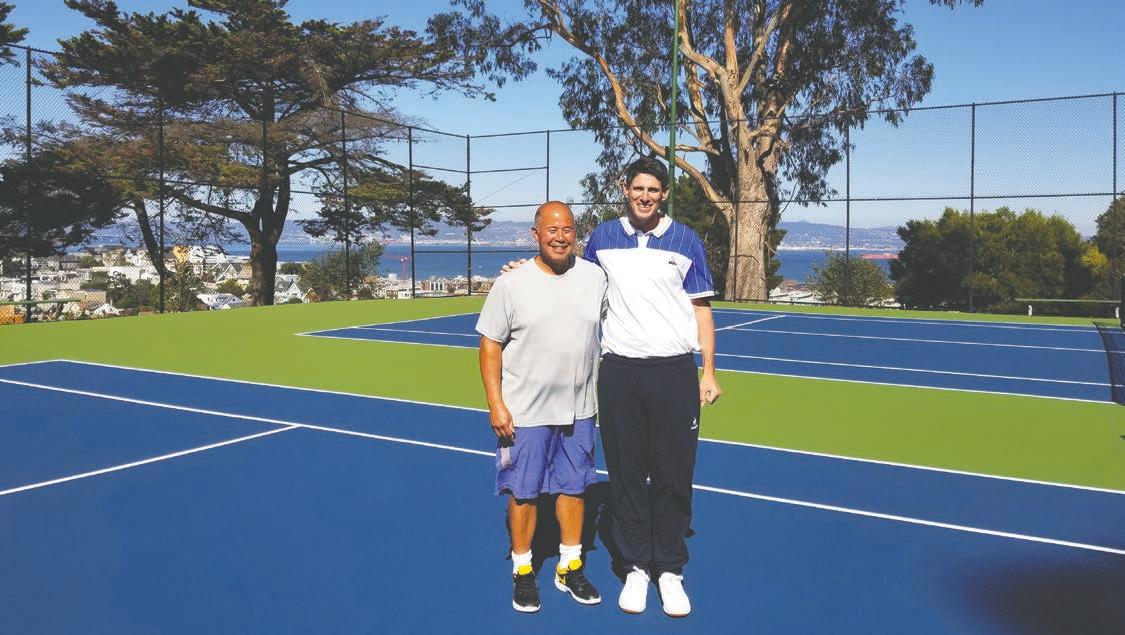

“If you don’t know Claudia, you should. Claudia was all over the details, read disclosures, pointed out risks and often challenged us as to whether the place was really right for us. It can be exhausting chasing a place in SF but Claudia understood what we wanted and did not compromise.”
– Mark C.

Golden Gate Park, following a 2017 arson incident that damaged many playground structures.
About $300,000 went to Let’sPlaySF!, a partnership between Rec and Parks and San Francisco Parks Alliance, a nonprofit that supports parks and open space in the City. Let’sPlaySF! wants to retrofit 13 San Francisco play areas, including Herz Playground in Visitacion Valley. Roughly $105,000 went to the Gene Friend Recreation Center, located South-of-Market, a portion of which was dedicated to buying 10 sport wheelchairs for pickup and organized wheelchair basketball games.
Socolow said SFFSR had to go through a lengthy City approval process to provide the $1,864,000 grant to Rec and Parks. “I think it’s turned out great. In Potrero Hill, the improvements give kids in the community an opportunity to play in brand-new recreational spaces. Not just one sport, but multiple sports,” said Socolow.
A grand opening of the new courts will be held at 4 p.m. on November 19 at the Potrero Hill Recreation Center.
BY DANITA KULPA black bird is loudly, rapidly, cawcawing in the tree outside your window. Others are flying in groups riding the air currents. Numerous black birds are eating on the ground. Are they Ravens or Crows? Sometimes they’re both or neither.
Ravens and Crows, which are abundant throughout the Bay Area, are scavengers, part of the “clean-up crew” of the bird world, eating carrion, garbage and, at times, nesting baby birds. They’re different species, both from the corvid family, genus corvus. Behavior, body structure and calls are the fastest ways to distinguish the two.
California’s Common Raven, corvus corax, is all black, and, when full grown, has a four-foot wingspan, measuring more than two feet long from head to tail. Their voice is more gravelly and deeper than Crows. Ravens stand and perch tall; more vertical than horizontal. They have large black heads, beaks, eyes, legs and feet. Everything about them is bigger and thicker than Crows. They can be surprisingly docile when raised as pets, though it’s not encouraged to keep them in captivity, and enjoy talking. They love to observe and have a wide range of sound mimicry. They hop. When flying, their tail arcs outwards in a softened “V” curve. A mnemonic: Raven has a “V” in it. They’re oftentimes seen in pairs or groups and, when flying, float on thermals and soar, with minimal wing flaps.
California’s Northwestern Crow, corvus caurinux, is, also, all black. Adults are easily half the size of a mature Raven, measuring 16 to 20 inches, almost half of which is tail. They “caw-caw”, although can mimic several other sounds too. Crows stand and perch more horizontally; their beaks look pointier, albeit still quite sturdy. All their features are black too, yet more refined.
Wild Crows and humans can form bonds of trust and friendship. When this happens, your Crow might bring you something shiny as a gift, much like they’d do for their mate in their nest. They’re social and can distinguish different humans by personality and whether they’re friend or foe. They walk and run along. When flying, the end of their tail is straight across; they rapidly flap their wings every few seconds, rather than soar. They’re oftentimes seen in groups.
Both Ravens and Crows are protected by the Federal Migratory Bird Treaty Act because they cross State lines. It’s illegal to hunt Ravens. However, some areas have an annual open hunting season for Crows from December to April, ending just as breeding and nesting seasons begin.
Birds weigh less than they appear. They have hollow bones for air flight. The best time to birdwatch is on overcast days, when reduced sun and glare allow for better viewing of silhouettes against the sky, which more easily shows flight patterns and body shape.
To hear Raven and Crow calls, as well as other birds: Audubon.org.
COMMUNITY | NOVEMBER

2 sat
Dia de Los Muertos: Festival of Alters Marigold Project presents the 26th Annual Festival of Alters. The making and viewing of traditional, contemporary, and experimental altars is a transformative experience that connects us to our ancestors. Bring flowers, eight-inch glass prayer candles, and mementos of loved ones to contribute to the community altars. To build an altar come to a workshop and join a group or build a personal one. All are welcome. 4 p.m. Free. Potrero Del Sol Park (La Raza Park), 25th Street and Potrero Avenue. For more information on alters, alter building guidelines, and ways to reserve your alter space: https://bit. ly/32HNOsX
Community: Potrero Hill History Night
Learn about growing up on Potrero Hill in the 1940s and 1950s from Rose Marie Sicoli. Hear about music and politics in the neighborhood during the 1960s and 1970s from Mat Callahan. See a preview of work-in-progress documentary Building Resilience in the Community by Ken Fisher and Mariangela Mistretta. The master of ceremony for the evening will be Goat Hill Phil. Dinner 5:30 p.m.: enjoy Goat Hill Pizza $3 slices; Chat’s Coffee desserts $2; Umpqua Bank beverages $1. All proceeds benefit San Francisco International High School. 7 to 9 p.m. Free. SF International High School, 655 De Haro Street. For more information: 415.863.0784
Family: MakeArt Family Day
For all ages, featuring tactile materials introductions for toddlers, guided activities for kids, and in-gallery hands-on opportunities for the whole family. Celebrate the season with a cornucopia of creative projects, including a handmade stamp and thank-you note station, wearable “vision board” buttons, gyroscope races and design-your-own ball bearing mazes. Quench your thirst at a lemonade stand benefiting the San Francisco-Marin Food Bank. Activities are free with admission; children 12 and under free. 11 a.m. to 3 p.m. Tickets — $6 to $8 — available for purchase at the door. Bring a food donation item for free entry. Museum of Craft and Design, 2569 Third Street. For more information: https://bit. ly/33Uw8dK
Science: Bay Area Science Festival
Discovery Day
The Bay Area Science Festival is Northern California’s largest free allages educational event. Organized by the University of California, San Francisco, Oracle Park is transformed into a science wonderland with more than 150 hands-on experiments, games, and demonstrations. Race robots, run on a liquid pool without sinking, play baseball with virtual reality technology, meet innovative people, explore every level of Oracle Park. 11 a.m. to 4:30 p.m. Free. Oracle Park, 24 Willie Mays Plaza. For more information: https://bit.ly/2zcWCcN
11/2 Saturday through 11/10 Sunday
Film: San Francisco Dance Film Festival
San Francisco Dance Film Festival 2019 offers something for everyone: art, documentaries, family films, live performances, shorts. The stories span an emotional range but share a common thread: compelling dance entertainment. Information programs, tickets, and venues: https://bit. ly/2JdO772
3 sun
11/4 to 11/25 Mondays
Hobby: Knitting Group
Every Monday a knitting group meets from 6:45 to 8:30 p.m.; open to newcomers. Free. Farley’s, 1315 18th Street.
11/4 Monday through 11/25 Monday*
Health: Monday Guided Meditation Guided meditations in a safe and welcoming space to help participants relax, heal, and center themselves. For new and experienced practitioners; all are welcome. Mondays, 6:30 to 7:30 p.m. Free. 824B Carolina Street. For more information: Zach Sharrin, 510.925.2559; zsharrin@gmail.com. *No class on 11/11.
5 tues
OTE!
1/7 Thursday through 11/21 Thursday*
Health: Thursday Meditation Lab Small group and one-on-one sessions available to help participants find a meditation practice that works for them. For new and experienced practitioners; all are welcome. Free. 1 to 2 p.m. Fraser Room, Potrero Hill Neighborhood House, 953 De Haro Street. For more information: Zach Sharrin, 510.925.2559; zsharrin@gmail. com *No class on 11/28.
9 sat
Horticulture: Garden Party
Live music, locally sourced food and drink. Every second Saturday of the month. Free. Noon to 5 p.m. Bay Natives Nursery, 10 Cargo Way. For more information: 415.287.6755.
Music: Karaj
Live music by Karaj, a Bay Area songwriter playing “acoustic folkin’ rock” along the Pacific Coast and beyond. 7 to 8:30 p.m. Free. Farley’s, 1315 18th Street.
14 thur
Food: Real Food Stories
Real Food Stories, in partnership with Whole Foods Market, will explore the theme of stewardship. What does it mean to be stewards of ourselves and our lands? How can we think more critically about stewardship as eaters? Speaker Dru Rivers, who has been farming for 36 years at Full Belly Farm, located in the Capay Valley, where she’s co-owner, managing and operating more than 400 acres of certified organic production. Full Belly grows more than 80 different crops,



providing year-round employment. Doors open at 6 p.m. for bites and drinks. Storytelling and question and answer session with Rivers 6:45 to 7:45 p.m. Dessert and extended conversation 7:45 to 8 p.m. Free, with option for $10 donation for two-drink tickets. Whole Foods Market, 399 Fourth Street. For more information and to reserve your place: https://bit. ly/2MGubf3
Design: An Evening with Roman Mars
Roman Mars presents a multimedia event that examines the unnoticed design that shapes our world.
Mars is the host and creator of “99% Invisible,” a radio show about unnoticed architecture. With more than 360 million downloads, “99% Invisible” is one of the world’s most popular design podcasts. 7 to 9:30 p.m. Tickets $25 to $60. Lecture at Minnesota Street Project, 1275 Minnesota Street. Following the lecture, there’ll be a private reception and meet and greet with Mars at the Museum of Craft and Design, 2569 Third Street. For more information and to purchase tickets: https://bit. ly/2pOzJv2
15 fri
Music: Kevin Patrick McGee
Live music by singer/songwriter
Kevin Patrick McGee, who combines finger style playing on six- and 12-string acoustic guitars with poetic, thoughtful, evocative lyrics in such genres as rock, folk, alt-country and bluegrass. A San Francisco Bay Area native, who has lived and traveled extensively in Europe and Japan, McGee distills people, places, and things, real or imagined, into serious and humorous songs of love, loss, and hope. 7:30 to 9:30 p.m. Free. Farley’s, 1315 18th Street.
16 sat
Music: Marc and CD Onofrio
Marc and CD Onofrio perform folk music, 7 to 8:30 p.m. Free. Farley’s, 1315 18th Street.
11/16 Saturday and 11/17 Sunday
Fair: Renegade Winter Craft Fair Market
Renegade Craft brings together makers and designers, interactive features, creative installations, small batch food and beverages, and good vibes. Grab a seasonal drink while workshopping with Bay views, groove to DJ sets, eat from local food trucks, and more. 11 a.m. to 5 p.m. Free. Fort Mason Center Festival Pavilion, 2 Marina Boulevard. For more information: https://bit.ly/2zJ96Jd




17 sun
Shopping: Fog City Flea at the Ferry Building
Fog City Flea showcases an eclectic lineup of makers and merchants from the Bay Area and beyond, offering handcrafted jewelry, apparel, accessories, apothecary, housewares, furnishings, and well-edited vintage. Curated exclusively for the Ferry Building by the team behind Upstate New York’s renowned Phoenicia Flea. Free. 10 a.m. to 5 p.m. San Francisco Ferry Building, 1 Ferry Building. For more information: https://bit. ly/2L5mgaw
20 wed
Food: Biblio Bistro Farmers’ Market
Cooking School
A live demonstration of how to sauté a featured vegetable at the Heart of the City Farmers Market, with Biblio Bistro, the San Francisco Public Library’s mobile kitchen. 11 a.m. to 2 p.m. Free. Heart of the City Farmers’ Market, United Nations Plaza, Market and Hyde streets. For more information: https://bit.ly/2qAE2uo. Biblio Bistro will be at the Farmers Market every third Wednesday of the month, weather permitting.
Music: Soul Delights
Live music by The Soul Delights, back with their collection of energetic rhythm and blues and other classic songs. Sing along and dance. 7:30 to 8:30 p.m. Free. Farley’s, 1315 18th Street.
21 thur
Performance: People/Places/ Performance
Through poetry, prose, live music, film, and audience participation, Michael Addonizio invites performers to explore the concept of portraiture — of the self, artists, and art forms — as it relates to the places in which we find ourselves. The evening will be infused with the spirit of the Blues; that American musical genre that’s influenced so many notions of the self in artistic practice. Performers include Addonizio, poets Susan Browne and Brittany Perham, and blues musicians Steven Freund, Beth Kohnen, Steve Ehrmann, and Paul Revelli. 7 to 9:30 p.m. Tickets $12 to $15. McEvoy Foundation for the Arts, 1150 25th Street, Building B. For more information and to purchase tickets: https://bit.ly/3617jic
Music: James Everett
Live music by singer James Everett, a San Francisco native who has a

sound and performance style that’s reminiscent of the Rat Pack fused with sprinkles of rhythm and blues, jazz, pop and neo-soul. 7:30 to 8:30 p.m. Free. Farley’s, 1315 18th Street.
Art: Gratitude
Collaborate with artists and makers, explore unique themes and rethink materials through creative design projects. It’s all about food and gratitude at the final MAKE of 2019. Come early for a free drink and artist happy hour featuring San Francisco restaurant + gallery, Palette. Step into the exhibitions for a plethora of hands-on projects inspired by the materials and concepts found in “Interior/Exterior.” Design your Thanksgiving aesthetic with decorative elements, including minibrick votives, table runners, and repurposed fabric throw pillows. Bring an old t-shirt or blanket from home for added personalization. Enjoy a creative gratitude meditation and grab a craft lemonade beverage, adult or otherwise, the proceeds of which benefit the San Francisco-Marin Food Bank. Vendor popup with local zerowaste culinary design company, Aplat. Tickets — $6 to $8 — available at the door. Cash/Square bar for guests 21 and over. Bring a food donation item for free entry. 6 to 9:30 p.m. Museum of Craft and Design, 2569 Third Street. For more information: https://bit. ly/2p6Uz8Y
23 sat
Music: San Francisco Chamber Orchestra “Nutcracker Sweet” Oakland Fairyland’s beloved puppeteers team up with the San Francisco Chamber Orchestra for a delightful version of Tchaikovsky’s holiday classic. Designed for young audiences, this production features the acrobatic antics of
The Puppet Company’s miniature cast accompanied by the Orchestra performing highlights from this beloved ballet. 2 to 4:30 p.m. Free; seating first-come, first-served. Noe Valley Ministry, 1021 Sanchez Street. For more information: https://bit. ly/2MGZPcB
24 sun
Food: Fall Chocolate Salon
Taste and experience the finest in artisan, gourmet, and premium chocolate. Find the perfect gifts. 10 a.m. to 5 p.m. Tickets, includes all tastings and events, $10 to $25. San Francisco County Fair Building, Golden Gate Park, 1199 Ninth Avenue. For more information: https://bit. ly/32SfJql
11/26 through 1/18/2020
Art: Cinthia Marcelle
In a new commission, Cinthia Marcelle converts the California College of Art’s Wattis Institute galleries into a temporary radio station for A morta, Marcelle’s first solo exhibition in California. Marcelle’s exhibition title and structure is drawn from the Brazilian poet and writer Oswald de Andrade’s 1937 play of the same name, A morta (The Dead Woman). The station will be on air 24 hours a day with programming ranging from DJ sets and lectures to comedy and news. aarea, an online platform founded in 2017 to showcase artworks created specifically for the internet, will contribute radio programming from São Paulo, Brazil, connecting American audiences across two continents. Opening reception: Tuesday 11/26/19, 5:30 to 8 p.m. Free. CCA Wattis Institute for Contemporary Arts, 360 Kansas Street. For more information: https:// bit.ly/2Jf0xM8





Mission Bay’s burgeoning population now has a diverse set of storefront windows in which to peer. “This is an exciting place,” said Emile Kfouri, owner of Row House. With two professional sports teams and concert venues drawing crowds to the neighborhood, an income-diverse residential and commuter population, and Gus’s as an anchor, he added, “It’s the perfect urban location.” Kfouri scouted out Mission Bay for his franchise a year ago. “It wasn’t very crowded then. You could tell it was going to be exciting, but it wasn’t exciting yet. In one year, it’s grown a lot. There are many more people now.”
Healthy Spot co-owners Andrew Kim and Mark Boonnark chose Mission Bay to open their first store outside Southern California by contemplating, “Where’s a community that’s underserved, growing, has a love for pets, and that we’d be able to participate in? When we put in that criteria, Mission Bay jumped to the top of the list,” Kim said. “This is a great opportunity to be part of a young, growing community.”
“It’s probably one of the most involved communities that I’ve been involved with, and I like that,” said Dr. Adam Jacobs, founder and owner of SF Custom Chiropractic. Jacobs wanted to expand his offices to Mission Bay since a buddy of his, who worked for Clark Construction while the University of California, San Francisco was being built, told him it was a place to watch.
“We’ve been involved in projects in Mission Bay over the past three or four years. We have been out there telling
the story of what we believe to be the opportunity for tenants in Mission Bay,” said Laura Sagues Barr, senior vice president for CBRE, a commercial real estate firm responsible for leasing retail spaces in One Mission Bay, a condominium building with fully leased retail spaces, and 588 Mission Bay Boulevard North, an apartment building with retail entrances in the 1300 block of Fourth Street, where two final deals are nearing completion.
“It was more storytelling with data before,” Sagues Barr said. “Now with the volume of people living here, and the shift toward offices in the area, the medical center and the Chase Center, it’s established. They can see what’s there. It’s a nice position for our investors to be in.”
Dogs stand attentively as handlers trim their coats with electric clippers at Healthy Spot, which opened last spring at 1200 Fourth Street. The company brought groomers from its Southern California locations to train local staff as part of an apprenticeship-type program.
“Not all dogs love the grooming process. Our team is trained to handle that. Half the skill of grooming is the behavior process, where you keep the dog calm and work with the dog and keep the stress down. Our groomers make it look easy,” Kim said. “We’re thorough and extensive in our investment on grooming, bathing and hair cutting. You don’t have to be an experienced groomer, but as long as you have passion and are able to work with our team, we’ll train you.”
The store sells premium pet foods, toys, and care items. Small dog daycare

is offered weekdays. “We provide the opportunity to take care of the whole relationship outside of veterinary needs and meet all other needs in a single place,” Kim said.
Healthy Spot hosts “pawties” for pet owners. “We create an atmosphere where people who love their pets can get together,” Kim said. The company is working on fitness-related events for 2020, including Doga – yoga with your dog – Yappy Hours and Play Dates, and has hosted events with SPARK Social – an outdoor food truck park –local meet-up groups and apartment complexes.
SF Custom Chiropractic plans to partner with gyms and fitness clubs, Jacobs said. Being the neighborhood’s only chiropractic office, “I expect to have a lot of new patients in the area; residents, employees of nearby biotech firms. I already treat some of the doctors at UCSF, and now will be closer to their location. Most people when they come to our office either live or work nearby and pop over.”
Jacobs described the method he and his team of four practice as “a combination of chiropractic and physical therapy. A lot of soft tissue work. Very popular with athletes, but everyone can benefit from it. We have knowledge to treat extremity injuries
such as shoulders, knees.” He expects each chiropractor will see 20 to 30 patients a day. Front desk staff are health care students. “They care a ton about people’s health and well-being,” Jacobs said.
As the name suggests, Row House’s program uses equipment that simulates rowing, with classes pulling together, like a boat crew. While music plays in the softly lit studio, students build aerobic endurance and muscular strength.
Kfouri said nearness to other fitness studios was one reason Mission Bay appealed to him. CorePower Yoga and PowerPlay, across from one another on the 1200 block of Fourth Street, and Lagree Fit 415, at 112 Channel Street, offer different exercise regimens. He believes proximity will favor all, defining Mission Bay as a destination for workout enthusiasts.
“Concentrating is a good thing. On Main Street, you’ll see three or four banks close to each other,” Kfouri said. “We’ve found people who have memberships at multiple locations. They like the complementary forms of exercise and socializing. I’m absolutely not competing with other fitness places here.”
Row House will offer six types
MISSION BAY continues on next page

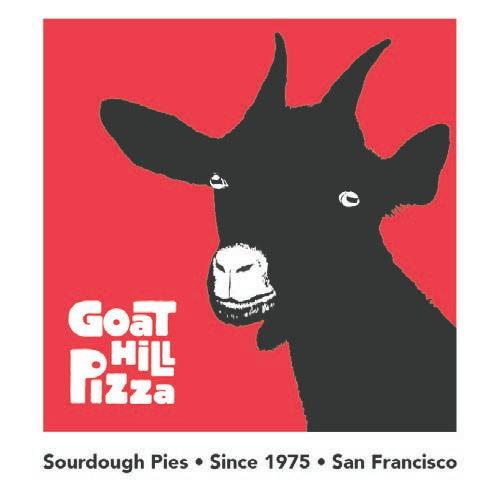
of classes. Choices include 90 percent of class time on the rowing machine with a 10-minute break in the middle; time split equally on the machine and floor exercises; and a full body workout that’s low impact with more stretching than rowing, which Kfouri described as, “A lot of fun. A 45-minute class goes by in no time.” Instructors will help with rowing technique to achieve an efficient workout. Row House also sells high-end athletic wear.
“I’ve been a competitive athlete since elementary school. It’s a community I understand and have respect and admiration for,” Kfouri said. Rowing appealed to him because, “It’s not meant to be competitive, but for everyone to pull together. We’re trying to build a community of diverse people.” Row House offers a 10 percent discount to first responders based in the Public Safety Building on Third Street, and residents of the area’s affordable housing.
Kfouri, Jacobs, Kim and Boonnark, presented their business concepts to the Mission Bay Citizens’ Advisory Committee (CAC) to secure approval from the Office of Community Investment and Infrastructure (OCII), the City agency overseeing completion of the Mission Bay South Redevelopment Plan. They noted that meeting attendees had a strong sense of community and acknowledged that Mission Bay is more welcoming to franchises and formula retail than other San Francisco neighborhoods, where formula retail must apply to the City’s Planning Department for approval.
Land uses in Mission Bay are permitted as either principal or secondary.
Principal uses are permitted without OCII approval and include restaurants, most retail, and art activities. Secondary uses include aerobic studios, doctor offices, and animal care. These are allowed, provided they generally conform with redevelopment objectives, planning and design controls, and OCII determines they’ll make a positive contribution to the area. CAC support is a step toward OCII approval.
A new Mattress Firm showroom opened in May, bringing home furnishings and a big business feel to the southwest corner of Fourth and Long Bridge streets.
“Allowing formula retail has been helpful as it pertains to Mission Bay,” Sagues Barr said.
Jennifer Dolin, Mercy Housing’s vice president of operations, praised Nancy Conover, a commercial leasing agent who passed away in June, for having filled all but one of the ground floor retail spaces at 1180 Fourth Street, an affordable housing complex. Under Conover’s management, Mercy Housing recruited neighborhood-serving, smaller businesses. “Nance really created the market there,” Dolin said.
Café Réveille opened in 2016, serving breakfast, lunch, and weekend brunch, with indoor and outdoor seating, on the northwest corner of Fourth and Long Bridge streets. As roasting headquarters for Réveille Coffee Company, patrons can see coffee cooked on a German-made Probat.
Back to the Picture, a framing and art shop with sister stores in the Mission District and South-of-Market, also opened in 2016, at 1160 Fourth Street. Casey’s Pizza has served thin crust pies, salads, craft beer, wine and dessert next door since 2017.
Family-owned House of Tadu Ethiopan Kitchen, at 1130 Fourth Street, expanded from its Tenderloin space to introduce foreign cuisine to the neighborhood in 2017 The artsy décor is Back to the Picture’s touch.
Mizu Spa provides personal pampering and beauty maintenance — manicures, pedicures, facials, waxing, and massage — in a tranquil setting that features soft music mingling with the white noise of trickling water. Fresh flowers bought at Gus’s brighten the reception area.
“We’re an urban spa, and we try to make it as peaceful and relaxing as possible,” said Nancy Lo, who owns the small business with a partner. Mizu Spa moved to 1150 Fourth Street in 2017, after 10 years on King Street, to avoid a steep rent increase. “We really wanted to stay within this area and keep our existing client base. This was the first area we looked at, and it ended up being the last. We saw there was a lot of growth, so we didn’t need to look any further,” Lo said. Most of Mizu Spa’s clients followed them to their new location, along with Lo’s employees; some have worked for her since she originally opened.
“I love this neighborhood. It feels more like a neighborhood here, compared to King Street,” Lo said. She and her staff shop at Gus’s, grab coffee at Café Réveille or from Joe & the Juice, which opened at 1155 Fourth Street in 2018. SPARK Social, Stagecoach Greens and the Mission Bay Kids Park in the triangular parcel where Long Bridge meets China Basin Street “are giving Mission Bay a diverse feeling as a neighborhood for families,” she said. Stagecoach Greens opened in 2018, in the Parklab Gardens bordered by
Mission Bay Boulevard North and South, Third and Fourth streets. The whimsical boom and bust, Gold Rush-themed mini golf course has food trucks and a bar. Cabanas and bungalows can be rented for parties.
“We’ve been very pleased with the great reception that the course has received,” said Rachel Rapaport, senior consultant for Stagecoach Greens. “In our first year we welcomed upwards of 100,000 people to the course. On a busy day, 500 or more people golf. Golfers are young and old, from San Francisco and from surrounding areas. During the week we often have large groups of professionals come for teambuilding. During the summer and on weekend mornings family groups come and golf. Weekends are the busiest, but weekdays can see surges, and warm weather makes a difference. Come Sunday through Tuesday evenings when we are quieter and more local. Also, weekday mornings when school is in session.”
Opened last spring, Woodland Creature Outfitters, at 1310 Fourth Street, sells toys, trinkets, T-shirts, costumes, curios, and books written by 826 Valencia afterschool writing program participants. Sale proceeds go to 826 Valencia, a nonprofit that provides services to under-resourced children and youth, ages eight to 18. Weekday afternoons youngsters crafting stories and essays under the tutelage of volunteers can be glimpsed in the enchanted forest at Fourth and China Basin’s southwest corner, across from the pups at Healthy Spot.
Last month, signs announcing that
MISSION BAY continues on page 14








Your Agent for Good. e-Pro, SRES
415.336.0754 | melinda@melindalee.realtor
Lic. #01344377 | melindalee.realtor
Experience and Expertise Go Hand-In-Hand
I say goodbye this month to Linda Clark, my real estate partner of 18 years. Linda taught me the value of listening to our clients, believing in yourself, and always being true to your word. She was an example and model for me through the peaks and valleys — and her hard and fast rule was, “Relationships matter.” I know that to be true, as so many of her friends on the Hill have become mine. It has been an honor and a pleasure to learn from the best. Cheers! Linda.



“Linda Clark and Melinda Lee teamed up in 2002 to serve the real estate needs of Potrero Hill clients. This Coldwell Banker team blended Linda’s long-time a liation on the Hill with Melinda’s knowledge of the rapidly changing real estate industry throughout the City.”
—Potrero VIEW 40th Anniversary Issue


Linda Clark
July 13, 1941 – October 11, 2019
Linda Clark, known to many as the “land shark” of San Francisco, passed away on October 11, 2019, in Walnut Creek, California. She was 78. In her final days she was surrounded by family and friends, toasting life with a glass of Chardonnay and her signature shock of blonde hair and gold earrings. She died from complications from chronic obstructive pulmonary disease
Linda loved San Francisco, hated tyranny and enjoyed a good joke, good food, good wine and a good time. She and her husband, Mario Sigüenza, were known for their backyard neighbor-
OBITUARY
hood parties with their friends’ live salsa band.
A residential real estate agent for Coldwell Banker in San Francisco for nearly 40 years, Linda was consistently a top sales agent in the City and Northern California. For decades, she lived on Potrero Hill, witnessing the community go from gritty to glitzy. She renovated her first Hill home mostly by herself. Later, as she had more funds, she contracted out for renovations, but nothing made her prouder than her own handiwork.
Linda was an engaged community member. She was a founding member of the Potrero Hill Democratic Club and a Potrero Boosters member. She supported the Potrero Hill Library, the Potrero Archives Project, and Potrero Hill Neighborhood House. For many years, Linda contributed to The Potrero View, an elegant volunteer staff member as well as crack typist and proofreader. She wrote articles and made an important contribution as an advertiser.
One of her favorite haunts was Specs bar in North Beach, where she was greeted like a long-lost friend, engaging in lively conversations with friends, new and old, that ranged from philosophy to politics. With an ability to connect with anyone, she was as much at home in a dive bar as a steak restaurant, always wearing her signature red lipstick.
Personal relationships were paramount to Linda; she collected friends like people collect art, cultivating the finest and most genuine persons from all walks of life. Her sharp mind kept her curious and engaged in community activism throughout her life. She firmly believed in civil rights for everyone along with the tolerance associated with those rights, and was a lifelong mentor, caring friend and favorite auntie to many.
She was born an advocate, first

fighting for her own right to do and be her best. She strongly believed in giving back and volunteered countless hours to the communities she lived in. She organized unions for farm workers, longshoremen, mill workers and other hard-working people on the West Coast. In her early professional years she worked directly under the tutelage of Harry Bridges.
In retirement, Linda and Mario restored two 120-year-old Victorian homes on a hill in Port Costa, a community of less than 200 souls, where the unofficial mayor’s only duty is to lead the Fourth of July parade. She loved this slice of small-town America and the people who dwelled there. Within those village lines – where candidates for mayor have included dogs, toddlers and musicians – she found a timeless community and continuity that scant few on this planet enjoy due to our fastpaced and turbulent times. She took long walks in the hills with her best friends, talking about the news of the day, organizing the Port Costa Conservation Society, helping to save a historic school, planning her next meal at the Bull Valley Roadhouse, and listening to the distant sounds of the trains coming and going along the Carquinez Strait at the bottom of Big Bull Valley.
In 2006, Linda started interviewing Port Costa residents to capture their memories. She and her videographer friend Betty Bailey questioned nearly 100 people. She was proud of these videos, which will be edited, transcribed and made a significant part of the Port Costa Museum at the Port Costa School.
“I have wonderful friends and enemies I’m proud of,” was one of her favorite quotes. As she approached death, she would shoo away any chaplains. “I would prefer a political theorist,” was another preferred saying. She wouldn’t miss a day reading the San Francisco Chronicle or a week reading The New
ing to a press release, “EBMUD has stationed portable generators and pumps at designated critical facilities in Berkeley, Castro Valley, Crockett, Danville, Moraga, Oakland, Orinda, Pinole and San Ramon.”
During PG&E’s October 9 forced power outage, “All 29 generators were activated and they worked well,” said EBMUD’s Andrea Pook. “We were glad to have them. We went through fuel a bit faster than anticipated. We estimate fuel costs to be $75,000 per shutoff event, which accounts for a five-day shutoff period each time power is cut.”
The View’s May 2019 article suggested that there are better ways to manage BUGs, by replacing them with battery storage technology and devising new policies to link clean energy BUGs to increase grid reliability. For now, though, California regulators are sticking by their BUGs.
“Since the article earlier this year, no new rulemaking efforts having to do with backup generators have begun,” BAAQMD’s Ralph Borrmann wrote in an email. “That’s not to say it couldn’t happen in the near future, but for the present there are no new rules being developed.”
Yorker or watching “60 Minutes.”
Linda loved to travel. She and Mario visited many places throughout the world, from the beaches of Rio de Janeiro to the shores of the Mediterranean, the mountains of El Salvador to the neighborhoods of Mexico City. She had a special ability to make immediate and meaningful connections with people from all walks of life.
Born in Wabash, Indiana, Linda also lived in Arizona and Oregon before settling in California for most of her career and retirement. Her memories of her early years in rural Arizona were adventures full of cowboys, Mormons and Native Americans.
She earned her bachelors from San Francisco State University and attended the University of Oregon in Eugene for graduate studies.
In addition to her husband, she’s survived by stepchildren, Veronica Rosen, Pablo Sigüenza, Joanne Sigüenza and Emilio Sigüenza; stepgrandchildren Bianca and Bella Rosen, August and Paloma Rodello, and Mateo Sigüenza; nephews David Jacobs and Michael Whitley; nieces Joy Bancroft and Beth Jacobs; and extended Sigüenza families throughout Mexico and El Salvador.
She was predeceased by her parents Oliver and Mildred Clark and her sisters Marjorie Jacobs and Jean Whitley.
In death, her friends and family know her only regret was that she won’t be able to continue to satisfy her innate curiosity. In remembrance of Linda, the family wishes you get off the fast lane, take special care of your family, stay in touch with your friends, enjoy a day of joy and laughter, and live life to the fullest. A party in Linda’s honor will be announced at a later date.
In lieu of flowers, contributions may be made to the Port Costa Conservation Society, 1 Plaza Del Hambre, Post Office Box 36, Port Costa, California. 94569-0036.
According to Borrmann, owners of 50 horsepower or greater stationary diesel or natural gas engines are required to secure a BAAQMD permit. “As part of applying for that permit, the Air District thoroughly reviews the engine’s potential emissions, possible impacts on nearby receptors, and compliance with District, state, and federal regulations. Based on the results of that evaluation, the Air District imposes strict operational and testing requirements on the engine that limit air quality and health risks to adjacent businesses and residents. These limits restrict the numbers of hours per year a permit holder can operate an engine for testing purposes. Also, based on an engine’s proximity to a school, the Air District imposes further restrictions to prohibit engine testing between 7:30 a.m. and 3:30 p.m. on days when school is in session,” he said.
The District’s rules were developed before the state’s investor-owned utilities began deploying power shutoffs as a way to manage wildfire risks, a tactic that’s now triggering far more BUG use than anticipated under air quality regulations, with associated polluting air emissions. It’s likely that
BUGs from previous page
in October alone thousands of the Bay Area’s BUGs were fired-up in response to PG&E’s forced outages.
BUGs may be swatted in specific communities that’re especially polluted. In West Oakland, an area with high levels of asthma-inducing particulate matter from transportation and industrial activities, as well as dozens of diesel-powered BUGs, The West Oakland Community Action Plan, developed by BAAQMD and civic group, West Oakland Environmental Indicators Project, calls for air filters to be installed at schools, Port of Oakland operations be transitioned to “zero-emissions” technology, and strategies be devised to reduce pollution sources. Under one plan element the Air District would provide “…subsidized loans for local small businesses to install energy storage systems (e.g. batteries, fuel cells) to replace stationary sources of pollution (e.g. back-up generators).”
Cooperation between the West Oakland Environmental Indicators Project and BAAQMD was encouraged by California Assembly Bill (AB) 617, which “requires local air districts to increase their focus on local air pollution in overburdened communities.” The legislation “directs the state and local air districts to identify communities in California that are exposed to high levels of air pollution and establish the Community Air Protection Program. Air districts with input from residents and stakeholders are to reduce exposure to particulate matter and toxic air contaminants.”
Without a battery backup residential solar photovoltaic arrays
provide no protection against electricity outages. Most solar systems are designed to pour power into the grid, not directly to household appliances. A solar/battery setup that provides enough power to charge a phone and operate several small LED lights can be purchased for roughly $150.
A battery backup system capable of powering a house costs from $10,000 to $20,000, according to website energysage.com, in addition to the price of solar panels, though federal, state, and local subsidies defray some of the expense. According to website solarreviews.com, a “typical” residential six-kilowatt solar system can be had for around $20,000, before grants and incentives.
Tesla’s “Powerwall”, a lithium-ion battery similar to the ones used in the company’s vehicles, costs $9,600, excluding installation, according to website Solarchoice.net.au. Another product, a power inverter, which attaches to a car’s battery and turns it into a generator, is available for under $1,000.
A standby diesel generator system that automatically kicks into gear when power goes out costs from $6,000 to $14,000. Smaller portable generators, typically gasoline-powered, are available at home improvement stores starting at around $800. During an emergency, however, generator owners would need to have ready access to fuel supplies, which may be difficult to obtain after an earthquake, fire, or forced outage.
players were more compelling than almost anyone we saw at the Opry.
Zack Green, who fronts for Birdtalker, sang with a beautiful intimacy that drew us in and held us tight. Debbie burst into tears after two stanzas of singer-songwriter Shawn Bryne’s first tune, about his toddler son making his life complete. We rushed the stage afterwards to see if it was available to purchase, but he’d yet to record it. Any town with a credible Listening Room is worth visiting at least once.
We moved to the Union Station Hotel, a magnificently converted 19th century train station. The building itself merits a gander, with its immense lobby that features a 65-foot barrelvaulted ceiling and 100-year-old Tiffany-style stained-glass windows. I visited the Frist Art Museum next store, where a well-curated Frida Kahlo show was on offer. Though I find Kahlo’s work ranges from pleasant to momentarily engaging, the exhibit revealed her importance as a distinct female artistic personality, a mid-century last breakthrough character along the lines of Madonna, a stepping-stone to Kim Kardashian, if the latter had artistic talent and a steelier inner strength.
At this point, after enjoying a handful of entertaining honkytonks, including one with a joyful house party vibe that attracted a mixed crowd of tattooed African- and EuropeanAmericans, we should’ve departed Nashville. But, trapped by premade plans that involved further travels to the East Coast and beyond, we stayed.
Two hours west of the city we found ourselves at a Christian Gospel festival held at Loretta Lynn’s “ranch,” she of Coalminer’s Daughter fame. Stars and strips decorated “United We Stand” stickers, along with bible
study materials, were disturbed at the entrance. We mumbled our way through the Lord’s Prayer alongside an audience of ghostly white true believers and listened to a half-day of praise songs which most of the performers lip-, and even guitar-, synched. Our spirit moved us to abandon the roadside Holiday Inn we’d booked – which had a rapey vibe reinforced by a strong chemical odor – and flee back to Nashville, landing at the quite nice, if business conventional, Omni Hotel. Praise the Lord!
The next day we drove two hours east of Nashville to the Muddy Roots music festival, which consisted of a dirt block long set of vendors’ tents that sold nothing anyone would want to buy or eat, with stages on either end. The bands shouted out their original punk rock meets country tunes, sounding mostly like they were trapped inside a shrieking cat that was having sex with some sort of other unidentifiable animal. Just don’t look at it directly in the eyes. I found it strangely compelling, but Debbie – who I’ve dragged to such places as Niger and Southern India – demurred.
It was a lovely drive back to Nashville. We’d semi-succeeded in walling off our worst anxieties about Sara, and the end of a family era. It was time to move to the next adventure, one perhaps not unlike the country songs we’d heard,
Daughter’s gone to college, all we can do is holler, and pay the resulting bill,
Mama’s feeling awful, wishin life was different, baby’s gone and broke her heart,

CLASSIFIED ADS
Legal Notices
The View now accepts legal notices. Please contact: production@potreroview.net; 415.643.9578.
Freelance Writers Wanted
Modest pay, interesting assignments. Contact: editor@potreroview.net
Muir Beach Vacation Studio
Walking distance to the beach, with the crashing waves visible and audible from the place. Includes kitchenette and lovely patio. $175 plus cleaning fee, two-day minimum. Editor@ potreroview.net; 415.643.9578.
Muir Beach Vacation Home
Walking distance to the beach, with the crashing waves visible and audible from the place. Three bedrooms, two baths, with a lovely deck. Minimum two nights: $350, plus cleaning fee. Editor@potreroview.net; 415.643.9578.
Writer's Companion
View editor available to work with writers at all levels. Groups also available. $50/hour. Editor@ potreroview.net; 415.643.9578.
Got something you need to sell? Have a service you provide? Our Classified Ad section is just the place for you! Cost: Each classified ad is $25 for up to 200 characters, including spaces. A 20-percent discount will be provided for ads paid for six months in advance. Payment, and/ or corrections, must be received by the 18th of each month for the ad to appear in the following month’s issue. Please email all classified ads to office@potreroview.net
MISSION BAY from page 11
Happy Lemon, a Taiwanese bubble tea shop, will be coming soon to 1320 Fourth Street, appeared in the storefront. A Bank of America is gearing up at 1335.
Not all went smoothly on the way to critical mass. Bimma Loft, a high-end furniture store and Mission Bay’s first retailer, moved to 50 De Haro Street last summer after six years at 1245
Fourth Street, driven out, in part, by sidewalk reconstruction to fix subsidence. Two other tenants of the block, PowerPlay and the UPS Store, weathered the path closure and remain open.
Locals awaited a Market Hall food mart for more than two years after it was announced in 2014. It closed a year later. Gus’s is thriving there now.
The spot opposite Gus’s, at Fourth and Channel, remains conspicuously vacant. “We’ve had five or six restau-
NEIGHBORHOOD BUSINESSES
NEW AD FORMAT FROM THE VIEW !
Let your neighbors know what you have to offer!
PREPAY: 2” x 2” 2” x 4”
6 months $345. $690. 12 months $555. $1,110.
Contact us: 415.643.9578 | production @ potreroview.net


doesn’t offer upfront revenue for space buildout, something a commercial developer can provide. Tenants need an investor or a loan to cover renovation expenses. “We’re affordable housing. Our investments are in housing, not retail,” Dolin explained. Competition from food delivery services and high business costs have contributed to more
Outreach November 2019
Get free, trusted help with your citizenship application!
restaurants closing than opening in San Francisco over the past year, ABC7 News reported in September.
Nevertheless, Dolin said, prospective tenants continue to inquire about the corner location. “They’re looking at this and thinking, ‘there’s a lot of potential there now. We see people on the sidewalks, people using the park
MISSION BAY continues on next page
The San Francisco Pathways to Citizenship Initiative provides free legal help from community immigration service providers at our free workshops. Resources for the citizenship application fee are available onsite. Learn more at sfcitizenship.org
When: Sunday, November 24, 2019. Registration is open from 9:30 am - 12:30 pm. No appointment needed!
Where: Chinatown YMCA, 855 Sacramento Street, San Francisco, CA 94108
Apply to become a census taker!
Every 10 years, the U.S. Census Bureau is responsible for conducting the nationwide census. The Census Bureau is re ruiti g ow to i orta t te orar ositio s wit great a 30 our a e i e ours or S ri g 2020. e a e sus Ta er a a e a i ere e i our o u it o i e at 2020 e sus.go o s.
Child support matters can be complicated, stressful, and confusing. The Department of Child Support Services helps parents understand the process so they know their rights and options for making and receiving support payments. a us to a at 8 901 3212 or isit our o e at 17 Missio Street to ear ow we a e ou. or atio is a so a ai a e o i e at www.s go .org ss.
Let Your Career Take Off at SFO
Discover Why SFO is a Great Place to Learn, Earn, Grow and Thrive it o s i a arts o t e air ort ro argo a se urit to air i es a o essio s o a ies at SF are always hiring!
isit s o. o areers or a 50.821.5242 to ear a out o o e i gs a t e e e ts o wor i g at t e a rea s largest airport.
Come see your local government at work!
Board of Supervisors Regularly Scheduled Board Meetings
November and December Meetings
The Board of Supervisors hold weekly meetings most Tuesdays at 2:00 p.m. in Rm. 250 of San Francisco City Hall. o . 5 o . 12 o . 19 e . 10 e . 17 T T T ST S . S S . F
Requests must be received 48 hours in advance required for interpretation. For more information see the Board of Su er isor s we site www.s os.org or a 415 554 5184.
MISSION BAY from previous page system. The new arena is going to bring crowds.’ There’s more and more interest in that space, day by day.”
PUBLISHER’S VIEW from page 13
Daddy’s rendered speechless, feeling darn right peek-ed, in for

lonesome time, Then the fightin started, barstools all a’ clobbered, life is just one big wheel…
We might return to Nashville someday, back to the Listening Room and a honkytonk or two. And if we do, no doubt we’ll be in a different mood, hopefully less bluesy, more country, ready to dance.
WE BELIEVE IN A HEALTHY FUTURE

We all want to make healthy choices. At Kaiser Permanente, you’ll get a wide selection of doctors to choose from. So you can find the one with the experience and the personality that best fits you and your needs. You deserve health care that’s simple, personalized, and hassle-free. Care and coverage that fits your life. Visit kp.org today because together we thrive.
kp.org





















